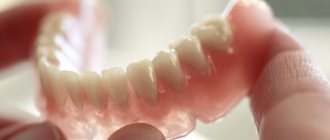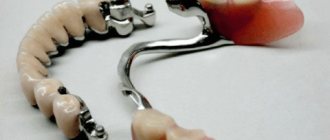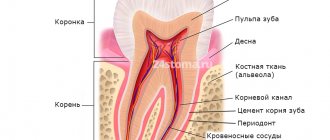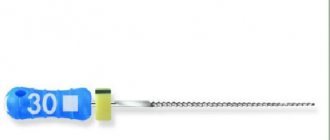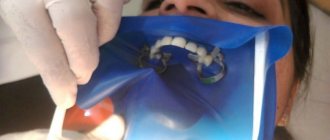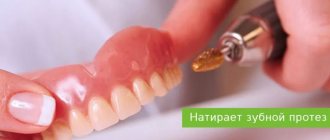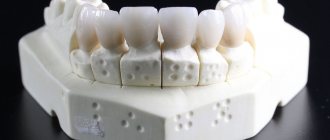When a patient comes in with extensive defects in the dental system, the dentist and dental technician are faced with the task of selecting a prosthesis design that would optimally replace missing teeth, restore chewing function, be invisible in the oral cavity and cause a minimum of discomfort. As a rule, in the absence of end supports, there is no talk about fixed prosthetics, so options for removable prosthetics are considered.
In many cases, such patients can be offered a partially removable clasp (arch prosthesis), which best meets all the stated requirements. It consists of a metal arched frame attached to the lingual or palatal side, so it takes up very little space in the mouth and is invisible to others. An acrylic base with artificial teeth is laid on top of the frame.
There are dentures with clasp (hooks) and lock (attachments) fastenings. Locks are more advanced and convenient options, due to the fact that they are located on the artificial crowns of the teeth closest to the prosthesis.
Design of Bredent clasp locking prostheses.
The design of a clasp denture consists of a frame and artificial gum, which is attached to the teeth using attachments - hidden clasps that are invisible and provide reliable fixation. A locking clasp prosthesis allows you to distribute the load over the entire frame, rather than focusing the load on the supporting teeth. The main feature of this type of prosthesis are attachments - micro-locks - which provide fixation of the prosthesis. At the same time, this design allows you to easily remove the clasp denture for cleaning or replacement.
Locking clasp denture on a dental model
Advantages
In addition to the already mentioned advantages of the clasp prosthesis, one can also name its other advantages:
- Possibility of simultaneous replacement of several dental defects located in different parts of the jaw;
- The chewing load is distributed over all teeth, gums and bone structures, and this brings the functionality of the prosthesis closer to physiological and does not entail rapid loss of bone tissue, which means that replacing the prosthesis with a new one is required much less frequently;
- The presence of an arc, rather than a plastic base, significantly reduces the size of the structure, makes it more compact and gives more freedom to the tongue;
- Due to the fact that the arch only partially covers the palate or gum of the lower jaw, the degree of disturbance of taste, tactile sensations and speech therapy disorders is reduced;
- The metal frame ensures structural strength and long service life of the product.
Design of attachments (locks) in Bredent clasp dentures.
The attachment or locks for bredent clasp dentures consist of a male (an element that fits into the lock) located on the supporting tooth (a spherical protruding element) and a matrix located on the clasp itself. The matrix is a special rubber band with an input part. To create such a design, the supporting teeth must be covered with crowns, and a male ball is pre-made on the crown.
Disadvantages of a clasp denture with a locking fastening
Choosing a clasp system with locks also has its disadvantages related to the design, materials and individual perception:
- initial discomfort for several days after installation;
- the need to grind the supporting and adjacent elements, remove nerves from living teeth on which locks need to be attached;
- It is impossible to install a prosthesis if less than 6 teeth remain in the dentition. In some cases, 8 support elements are required;
- the possibility of developing an allergy to metals that make up the alloy of the structure;
- fragility of fastening elements. After a break, the lock cannot be repaired and a new prosthesis must be ordered;
- Since 50% of the load during chewing falls on the supporting teeth and 50% on the gums, over time the jaw bone tissue atrophies and decreases in volume.
Prosthetics with locks for the lower jaw can be prevented by an anatomical feature of the structure - a short frenulum of the patient's tongue. In this situation, the clasp design will cause pain and discomfort. The patient and specialist will have to consider another prosthetic option.
Due to the loss of bone volume, these structures require constant and competent care and periodic adjustment of fit. It is recommended to visit an orthodontist once a year to check and correct deficiencies.
Classification of attachments (locks).
The attachment or lock is one of the main distinctive design features of this type of dentures. Currently, there are several types of lock classifications. Based on the material of manufacture, attachments are divided into metal and plastic. Metal locks have a standard shape and size, while plastic locks are made to order based on the structural features of the dental system. Depending on the location of the lock, attachments are also divided into rod, crossbar and rail. Connections can be mechanical, magnetic or screw. The most common type of fastening of a lock on an attachment is a ball-shaped one, where a metal ball is used as a patrician, and the matrix is made from plastic according to individual orders (Bredent). The spherical fastening provides reliable fastening and is completely invisible in the oral cavity, unlike, for example, clasp clasp dentures.
Manufacturing process
The production of the prosthesis begins after examining the patient, making a diagnosis and making a diagnostic model of both jaws. It is necessary so that the technician and dentist can calculate the number and placement of attachments, and then design a model of the future prosthesis. After this, they begin to sanitize the oral cavity and prepare the supporting teeth for covering them with crowns (treatment of caries, depulpation, installation of pins, grinding). The next stage is taking a silicone impression, which is sent to the laboratory. Temporary crowns are attached to treated and prepared teeth.
Based on the dental impressions obtained, the dental technician makes a frame for the supporting teeth with a matrix and gives it to the doctor for fitting and fitting in the patient’s oral cavity. At the same visit, the color of the future ceramic veneer of ceramic crowns is determined. At the next visit, the finished crowns are fixed with temporary material, the impression is taken again, this time to make the clasp. The crowns, along with silicone impressions, are sent to the laboratory, and temporary crowns are placed on the ground teeth.
In the laboratory, a wax model of the clasp with teeth is first cast, then the final version of the prosthesis is made and carefully verified on working plaster models of the jaws with the patient’s teeth. The finished product is transferred to the clinic.
The dentist fixes metal-ceramic crowns with permanent cement, checks the quality of the locks, makes minor adjustments and places the prosthesis on the patient. At the end of the appointment, the doctor teaches the patient the rules for putting on and removing the denture, caring for it and the oral cavity, and also sets a date for a follow-up examination.
Indications for installation of clasp dentures on attachments.
This type of prosthesis can be installed in the following cases:
- partial absence of teeth;
- impaired chewing function due to the lack of several teeth;
- pathological abrasion of teeth;
- various types of dental diseases, including periodontal disease (periodontitis, periodontal disease);
- various types of diseases, for example, diabetes or blood disease, for which implantation is contraindicated;
- malocclusion or unsatisfactory aesthetics.
How to care for clasp dentures with locking fixation
To extend the life of removable structures, they must be cleaned after each meal, at least 2 times a day - morning and evening. They are cleaned with a toothbrush and rinsed thoroughly under running water.
The structures are disinfected in a special antiseptic solution, which eliminates bacterial plaque and prevents corrosion and the appearance of dark spots.
Toothpaste should not contain abrasives or aggressive chemical compounds such as soda or citric acid. These components can react with the alloy constituents and cause oxidation, causing dark spots to appear on the surface. The toothbrush should not be hard - the slightest scratches and microcracks also reduce the service life of the denture and worsen the aesthetic impression.
After installing clasp structures on locks, it is advisable not to drink large quantities of coffee, tea and other drinks containing dyes. It is also necessary to stop smoking. The dark plaque formed during use cannot be removed at home and requires a visit to the dentist for proper cleaning.
To check the stability of the attachment and the condition of the bone tissue, you should visit an orthopedic dentist once every 6 months. At the appointment, you can carry out professional cleaning of the supporting teeth and comprehensive cleaning of the clasp structure.
Manufacturing stages and installation
To install a locking clasp prosthesis, two main stages must be completed - clinical and laboratory. At the first stage, the doctor conducts an examination, collects anamnesis and determines what exactly the design should be. Impressions are also taken and preparation for prosthetics is carried out. If necessary, a temporary structure will be installed while the main structure is being manufactured. The laboratory stage includes the process of making a clasp, taking into account casts, anatomical features and other factors. Fitting and correction are required, after which a permanent prosthesis is made. Installation takes about half an hour, the patient receives recommendations on care, cleaning of the structure, and features of removing the product.
Advantages
The advantages of using a prosthesis with a locking fastening are:
- compact dimensions of the product;
- no violations of taste, diction;
- aesthetic appearance;
- the patient does not experience discomfort;
- the design can be worn around the clock;
- high strength;
- simple daily care;
- the fastening is reliable, the risk of accidental displacement is eliminated;
- service life – 10 years.
Care and storage
The peculiarity of a clasp denture with locks is that it is easily and securely attached; it is not necessary to remove it at night. Usually this is only required for home cleaning with special tablets or liquids on the recommendation of a doctor. The patient must also follow the following rules:
- daily cleaning with soft brushes and non-abrasive pastes, using an irrigator to remove food debris;
- After each meal you need to rinse your mouth;
- Regular visits to the dentist are needed for preventive examination, correction or repair of the product, and timely treatment.
Price
The price of prosthetics using clasp structures depends on many factors. This is the condition of the oral cavity, patient compliance with hygiene rules, type of product and fixation. When calculating the cost, the doctor takes into account diagnostic and therapeutic measures, materials for making crowns and frames. The dentist will be able to give exact prices only after a preliminary examination and a series of studies. On average, one unit will cost the patient 15 thousand rubles; when making a full prosthesis, the price will be higher and can reach 40-60 thousand.
Design and types
Lock fastening is divided into two types - classic clasps and attachments. In the first case, hooks are used to secure the product to the supports. The second type involves installing a permanent frame in the form of pins into which part of the lock is mounted. When installing the second crown part, the lock snaps into place, creating a secure attachment that is resistant to movement.
Clasp dentures with attachments are distinguished according to various parameters, including the type of locks. Fixation can be rotational, rigid or hinged. Differences also relate to the materials used to make the non-removable part. For this, various alloys can be used, including precious metals. The crown part is made of durable polymer or metal-ceramic, which depends on the operating requirements and expected loads.
